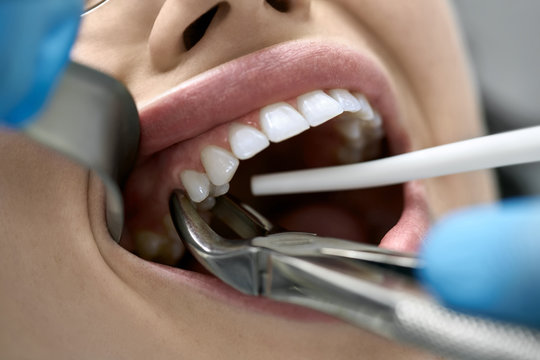Tooth Extraction: A Guide to Understanding the Procedure
Tooth extraction is a dental procedure that involves the removal of a tooth from its socket in the jawbone. While preserving natural teeth is a priority in dentistry, there are situations where tooth extraction becomes necessary.
Whether it's due to severe damage, advanced decay, overcrowding, or to prepare for orthodontic treatment, tooth extraction is a common and often straightforward dental procedure. In this comprehensive guide, we will explore the reasons for tooth extraction, the types of extractions, the procedure itself, aftercare, and the importance of tooth replacement.

Reasons for Tooth Extraction
- Tooth Decay: Advanced tooth decay that has compromised a tooth's structure may require extraction if it cannot be effectively restored with a filling or crown.
- Gum Disease: In severe cases of periodontal disease where teeth have become loose and are no longer securely anchored in the jawbone, extraction may be necessary to prevent the spread of infection.
- Impacted Wisdom Teeth: Wisdom teeth, also known as third molars, often do not have enough space to erupt properly and can become impacted, causing pain, infection, or damage to neighboring teeth.
- Orthodontic Treatment: In some cases, orthodontists recommend tooth extraction as part of a treatment plan to create space and achieve proper alignment.
- Crowding: Overcrowding of teeth can lead to misalignment and bite issues, requiring the removal of one or more teeth to create space for proper alignment..
- Fractured or Traumatized Teeth: Teeth that have suffered severe trauma or fractures that cannot be repaired may need to be extracted.
- Extra Teeth: Supernumerary teeth, or extra teeth, can sometimes interfere with the development of the normal dentition and require extraction.
Types of Tooth Extractions
- Simple Extraction: Simple extractions are typically performed on visible teeth that are easily accessible. The dentist uses special instruments to loosen and remove the tooth from its socket.
- Surgical Extraction: Surgical extractions are more complex and are used for teeth that are impacted, partially erupted, or broken at the gum line. A small incision is made in the gum to access and remove the tooth.
The Tooth Extraction Procedure
The tooth extraction procedure typically involves the following steps:
- Anesthesia: Local anesthesia is administered to numb the area around the tooth to ensure the patient is comfortable and pain-free during the extraction.
- Loosening the Tooth: For simple extractions, the dentist uses specialized tools to gently rock the tooth back and forth, loosening it from the surrounding bone and ligaments.
- Extraction: Once the tooth is sufficiently loosened, the dentist uses forceps to grasp the tooth and carefully remove it from the socket. For surgical extractions, a small incision may be made to access the tooth.
- Socket Cleaning: After the tooth is removed, the dentist may clean the socket to remove any remaining debris or infection.
- Sutures (if needed): In the case of surgical extractions, the dentist may use sutures (stitches) to close the incision.
Tooth Extraction Aftercare
Proper aftercare is essential to promote healing and prevent complications after a tooth extraction. Some important considerations include:
- Pain Management: Over-the-counter or prescribed pain medications may be needed to manage any discomfort following the extraction.
- Ice Packs: Applying ice packs to the affected area can help reduce swelling and alleviate pain.
- Soft Diet: Patients should stick to a soft diet for a few days after the extraction to avoid putting excessive pressure on the healing socket.
- Oral Hygiene: While the extraction site heals, it's essential to maintain good oral hygiene by gently rinsing with warm saltwater and avoiding vigorous brushing or rinsing.
- Avoid Smoking and Alcohol: Smoking and alcohol can interfere with the healing process, so it's best to avoid them during the initial recovery period.
- Follow-Up Appointments: Attending follow-up appointments with the dentist is crucial to monitor healing and ensure there are no complications.
Importance of Tooth Replacement
After a tooth extraction, it is often recommended to consider tooth replacement options. Leaving the space empty can lead to various issues, including:
- Shifting Teeth: Adjacent and opposing teeth may gradually shift into the empty space, leading to misalignment and bite problems.
- Bone Loss: The jawbone may begin to resorb or deteriorate in the area where the tooth was extracted, which can affect facial aesthetics and the stability of neighboring teeth.
- Functional Impairment: Missing teeth can make chewing and speaking more challenging and may affect one's ability to enjoy a varied diet.
- Aesthetic Concerns: Gaps in the smile can cause self-esteem and confidence issues, affecting one's overall quality of life.
Tooth replacement options following an extraction include dental implants, bridges, and removable dentures. These options are tailored to the patient's specific needs and circumstances, providing functional and aesthetic benefits.
Tooth extraction is a common dental procedure that becomes necessary for various reasons, including severe decay, gum disease, impacted wisdom teeth, orthodontic treatment, and more. While the thought of tooth extraction may seem daunting, advances in dental techniques and anesthesia ensure that the procedure is typically straightforward and well-tolerated. Proper aftercare and considering tooth replacement options are essential for maintaining oral health, function, and aesthetics. Consulting with a skilled dentist can help individuals

